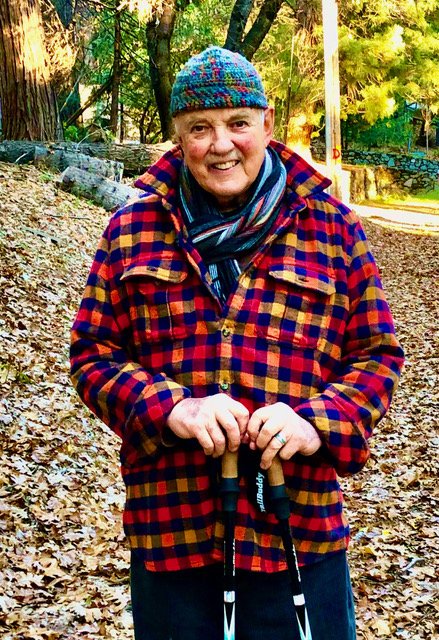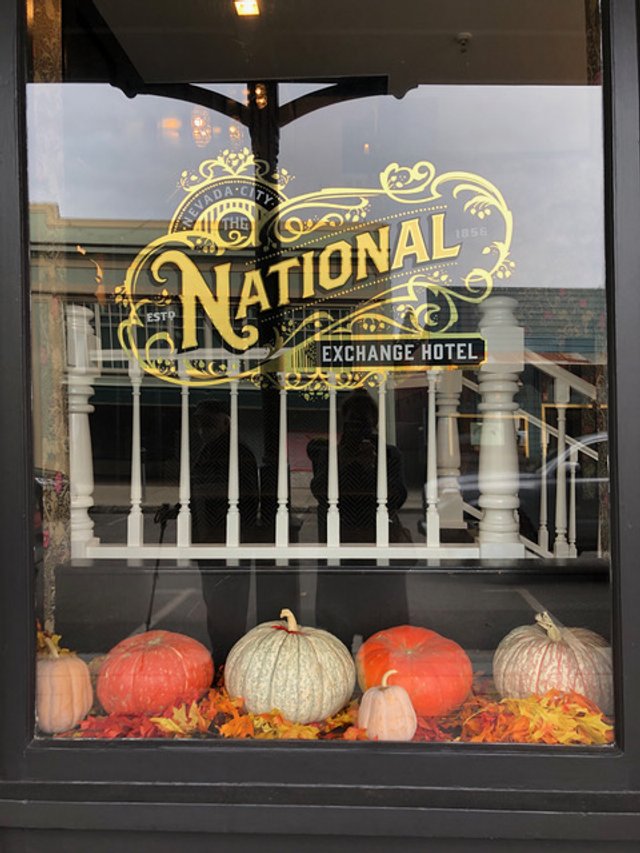The Other Side of Midnight
Seasonally speaking, a spectacular showing of fall colors were on display from October into November here in the Sierra Foothills. Our neighbors proclaimed it to be the best autumn they’ve ever experienced. A rich palette of fiery color resulted from an extremely dry summer followed by a seasonal drop in both daytime and nighttime temperatures. Light summer clothing was switched for warmer wear that had been stored since our April arrival in spacious built-in, cedar-lined cupboards that line two of the walls of our garage. And late afternoon walks with wool scarves wrapped round our necks replace early morning walks as we experienced ever shorter daylight hours.
Spectacular moonrises over Nevada City’s historic Broad Street are also visible over the tall pines and firs at 3,750’ where we live nearby. But last week’s partial-lunar eclipse that promised a spectacular Blood Moon was unfortunately blocked out by clouds and overnight rain, mirroring new territory in the dark we have come to refer to as “the other side of midnight.”
For the past two months, Kit has been dealing with bilateral shoulder pain that has wreaked havoc with his ability to sleep. One tear is from an old torn rotator cuff in his left arm (possibly from a move 16 years ago and the other from our April move from MO to Nevada City. Moving halfway across the country and beginning a new chapter in life is physically taxing and mentally discombobulating at any age, especially during a pandemic that continues to be demanding.
While the move has been wonderful in many ways and we are enormously happy with where we’ve landed, the landing has been tough physically for Kit. After two MRIs, he has had a steroid shot in one arm and is wrestling with whether or not to schedule orthoscopic surgery in the other—a procedure that would require that his right arm be in a sling for two months. No activity. No typing on a keyboard. And 60 nights of difficulty getting comfortable enough for sleep to come.
Ah, sleep, that much needed window of time when the mind settles enough to allow the body to rest and recharge. Steroids, we’ve learned can lead to insomnia, feelings of anxiety, dark dreams, and depression—making the most beautiful of days feel heavy and sad. Dark thoughts creep into nighttime hours and all you want is a return to normalcy and light. A night’s sleep doesn’t happen because the mind influenced by steroids is over-active and before long, you forget how to sleep. In Kit’s case, the eternal optimist suddenly feels unstable and like someone sailing without a rudder.
At this point, I tell Kit about Colson Whitehead’s new novel, Harlem Shuffle and “Dorvay”—a term the author introduces during the second of the three sections of his novel. A mis-hearing of the French “dorveille”, dorvay refers to a period of awakeness in the middle of the night when the mind (or characters in Whitehead’s novel) go this way or that. Fascinated by the term and how it seemed to mirror Kit’s nighttime periods of awakeness, I dug deeper and found a fascinating March 31, 2016, article in The New York Magazine by Jesse Barron on “Segmented Sleep.”
Barron describes having begun to feel out of sync after experiencing a period of insomnia. After nodding off one night at 8 p.m., waking up at 2 a.m., brooding for a few hours, and then sleeping again until 6 a.m. a pattern began that led to “a forgotten, ancient tunnel to the other side of midnight: segmented sleep.” This period between “first” and “second sleep” was, Barron writes, “once the most natural thing in the world.”
The article goes on to say, “In 2001, historian Roger Ekirch unearthed segmented sleep in the cultural history of pre-19th-cenury Europe” when dorveille was ubiquitous. Charles Dickens took middle of the night walks around London. Benjamin Franklin took “cold air baths” while standing naked at his open windows. “Exposed over several weeks to preindustrial light conditions,” Barron contends, “most of us will gradually start sleeping twice a night, hooked to the Ur-rhythm of our internal clock.”
As dorveille began to segment Kit’s nighttime sleep pattern, I suggested he should embrace the 2 hours of awakeness and use them productively. Work on his Monday Musings in his study. Catch up on written correspondence (he loves sending postcards to friends and family). Tidy up his desk. Or times when I join him in the living room by our hearth and read novels aloud to helped take his mind off being anxious about not sleeping though the night. Over the next week, I read Louise Penny and Hillary Rodham Clinton’s political thriller State of Terror aloud to him from cover to cover! Currently I’m rereading Amor Towles’ A Gentleman in Moscow aloud to Kit in the wee hours of the morning until our eyelids grow heavy and we’re ready for the night’s second sleep.
As Kit makes his way back to a healthy balance been sleep and awakeness, I continue to fill the in-between hours with writing, reading, and preparing for the coming holiday season. For Thanksgiving, we shared a vegetarian Thanksgiving meal with our daughter Heidi, her wife Sugie, and two of their friends. Next weekend, our son Hayden arrives from Spain with our grandson Nicolas. There will be shared meals at home, stories, laughter, and an evening at Lola—a favorite restaurant at the National Exchange Hotel on Broad Street where gas lamps light up the town each night and annual Victorian Christmas activities are getting underway.
As November comes to an end, December arrives with an abundance of festive lights and hope. And that is indeed a blessing.




